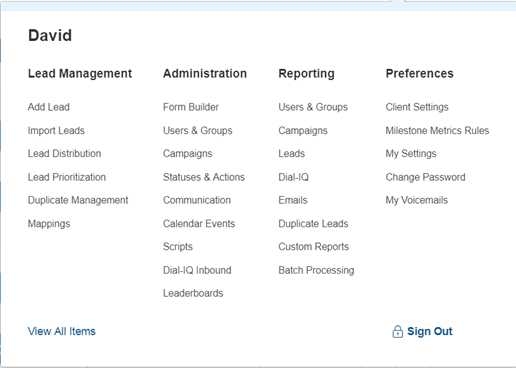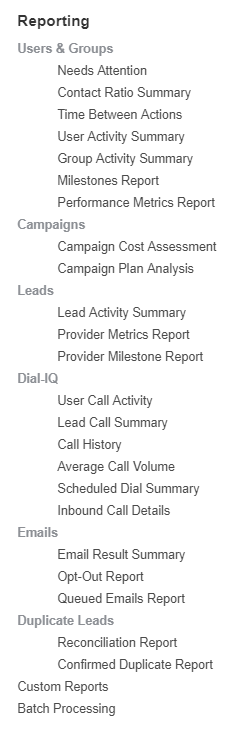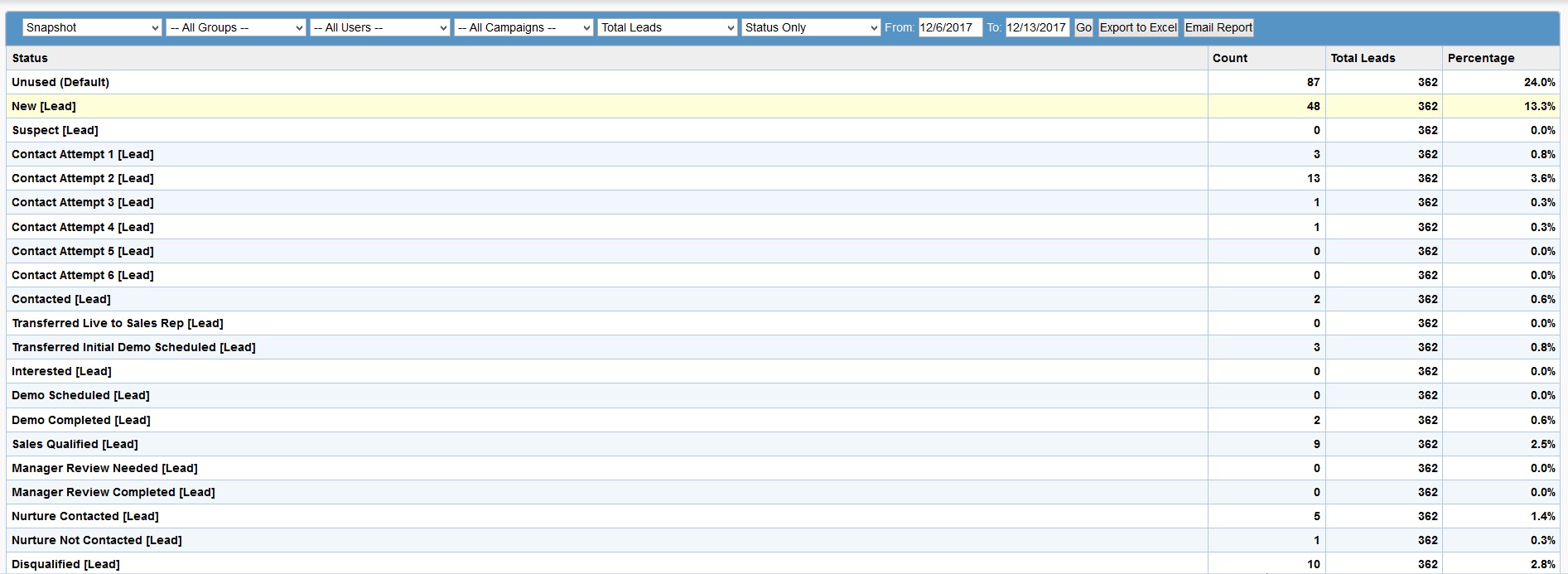Standard Reports: Lead Activity Summary
TOPICS COVERED IN THIS ARTICLE
- How to run the Lead Activity Summary Report
ENVIRONMENT
LeadManager
STEP BY STEP INSTRUCTIONS
The Lead Activity Summary report provides information on the status of your leads.
Our most successful clients use this report in several different ways:
- Track the overall status of the leads within their LeadManager
- Identify various performance metrics and ratios (such as an Application Ratio and Funding Ratios)
- To track the percentage of leads that reach a certain status
- Identify the current and historical status of leads belonging to a particular group or user
- Identify the current and historical status of leads originating from a particular campaign (lead source)
- Identify the number of times a particular action has been taken on leads
Access the Menu page by clicking on your name in the upper right of the header.

Click View All Items.

Under Reporting / Users & Groups, click Lead Activity Summary.

Apply Filters
There are several useful options when running the report.

Snapshot and Historical views: See Snapshot vs. Historical
- Date range filtering: To the left of the Go button, specify a start and end date. This will filter the leads used to generate the report based on the date on which they were added to your LeadManager. For instance, you might compare the contact ratio of the leads you received last month to the leads that you received in the prior month.
- Group filtering: You can filter the output of this report by group. This is useful if you wish to compare the performance of different teams. If a group manager is given access to reports, they will only see the performance of their own team.
- User filtering: You can see the performance of an individual user in your LeadManager. To see detailed information on multiple users, run the User Activity Summary report instead.
- Campaign filtering: You can filter the leads used to generate this report based on campaign.
- Total Leads vs. Previous Status: This is useful only to a tiny minority of our clients who have a completely linear sales cycle.
- Status Only vs. Status and Action: See Statuses vs Actions.
Snapshot vs. Historical
- Instead of providing information about the current status of each lead, a Historical report provides information about the number of leads that have ever been in a given status. To run the Lead Activity Summary as a Historical report, select “Historical” from the Snapshot dropdown menu in the upper-left-hand corner of this report.
- This is easier to understand with an example. Suppose you generate 10 leads in the New Four of these leads move directly to the Application status. Of these four, two then go to the Fundedstatus, and two then go to the Inactive status. The other 6 move directly to the In Process status, then on to the Inactive status.
- It’s easy to see the value of the Historical report in this context. From the Snapshot view, we can only determine that 20% of our leads eventually arrive in the Funded status, and 80% of our leads arrive in the Inactive status. We can deduce that we have a 20% funded ratio, but we don’t know what got us there.
- From the Historical view, it’s easy to determine that 40% of our leads generate applications. So, we can say that we have a 40% application ratio. We can also see that 20% of our leads are funded, and 80% become inactive.
|
New |
In Process | Application | Funded | Inactive | |
|
Snapshot |
0 (0%) | 0 (0%) |
0 (0%) |
2 (20%) |
8 (80%) |
| Historical |
10 (100%) |
6 (60%) | 4 (40%) |
2 (20%) |
8 (80%) |
Statuses vs. Actions

The Lead Activity Summary can provide information about the number of times that an action has been taken on your leads. To see this view, select “Status and Action” from the View drop-down menu. For each status in your LeadManager, the report will now display the list of actions that can be taken within that status, along with a count and percentage.
Counts presented do not distinguish as to which status the lead was in when the action was taken. For instance, suppose you have a “General: Comment” action available for use within the New and In Process This action may have been taken 50 times in the New status, and 50 times in the In Process The report will list the “General: Comment” action within both the New and In Process statuses, each time indicating that the action was taken 100 times. You can use Custom Reporting if you need more specific data.
Running the report
Run the report by clicking the Go button.
Example Results
